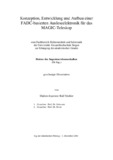Citation link:
https://nbn-resolving.org/urn:nbn:de:hbz:467-1887Files in This Item:
| File | Description | Size | Format | |
|---|---|---|---|---|
| stiehler.pdf | 7.76 MB | Adobe PDF |  View/Open |
| Dokument Type: | Doctoral Thesis | metadata.dc.title: | Konzeption, Entwicklung und Aufbau einer FADC-basierten Ausleseelektronik für das MAGIC-Teleskop | Authors: | Stiehler, Ralf | Institute: | Fachbereich 12, Elektrotechnik und Informatik | Free keywords: | FADC, Magic-Teleskop, Cherenkov-Teleskop | Dewey Decimal Classification: | 620 Ingenieurwissenschaften und Maschinenbau | GHBS-Clases: | YFBV | Issue Date: | 2001 | Publish Date: | 2006 | Abstract: | Thema dieser Arbeit ist die Enwickling eines Auslesesystems für die Kamera des MAGIC-Teleskops. MAGIC ist eine Abkürzung für Major Atmosphere Gamma Imaging Cherenkov-Telescope. Bildgebende atmosphärische Cherenkov-Telekope (englisch IACTs) sind erdgebundene Teleskope zur Detektierung von hochenergetischen Teilchen, insbesondere von Gammastrahlung. Diese kosmischen Teilchen werden indirekt über Cherenkov-Licht detektiert, welches durch Teilchenshower primärer Teilchen im oberen Bereich der Atmosphäre erzeugt wird. Die am Teleskop eintreffenden Lichtpulse sind von extrem kurzer Dauer und können nur durch sehr schnell abtastende A-D-Wandler registriert werden. Beim MAGIC-Experiment ist eine parallele Abtastunng aller 640 Kamerapixel-Ausgangssignale mit 300 MHz FADCs vorgesehen. Bei Entwicklung und Test wurde besonderer Wert darauf gelegt, dass ein sehr hoher Datenfluss bis 80 MByte/s und eine synchrone Clockverteilung mit einer Genauigkeit im Bereich weniger Pikosekunden ermöglicht wird. Im Rahmen der vorliegenden Arbeit wurde ein 32-Kanal-Teilsystem, das alle Komponenten des endgültigen Aufbaus beinhaltet, aufgebaut und erfolgreich getestet. Dieses Prototypensystem kann als Kern der 640-Kanal-Auslese angesehen werden, welches am Bestimmungsstandort des Teleskops im Laufe des Jahres 2002 aufgebaut wird. The subject of this thesis is the development of a readout system for the camera of the MAGIC telescope. MAGIC is an acronym for Major Atmosphere Gamma Imaging Cherenkov-Telescope. Imaging Atmosphere Cherenkov-Telescopes (IACTs) are ground-based telescopes for the detection of very high energy particles, in particular gamma rays. Such cosmic particles are indirectly detected by the Cherenkov light which is produced by particles of a shower induced by primary cosmics in the high atmosphere. The light pulses arriving at the telescope are extremely short and can only be registered by digitizing with a high sampling frequency. For the MAGIC experiment a parallel sampling of all 640 camera pixel output signals with 300 MHz FADCs is foreseen. The design and testing has been carried out particularly with regard to enable a relatively high data flux of up to 80 MByte/s and to facilitate a highly synchronous clock distribution with a precision in the order of a few picoseconds. Within the scope of the present work, a first 32 channel subsystem containing all components of the final system has been developed and tested successfully. This prototype system can be considered as a nucleus for the 640 channel system, which will be implemented at the MAGIC experiment site throughout the year 2002. |
URN: | urn:nbn:de:hbz:467-1887 | URI: | https://dspace.ub.uni-siegen.de/handle/ubsi/188 | License: | https://dspace.ub.uni-siegen.de/static/license.txt |
| Appears in Collections: | Hochschulschriften |
This item is protected by original copyright |
Page view(s)
330
checked on Nov 25, 2024
Download(s)
259
checked on Nov 25, 2024
Google ScholarTM
Check
Items in DSpace are protected by copyright, with all rights reserved, unless otherwise indicated.

